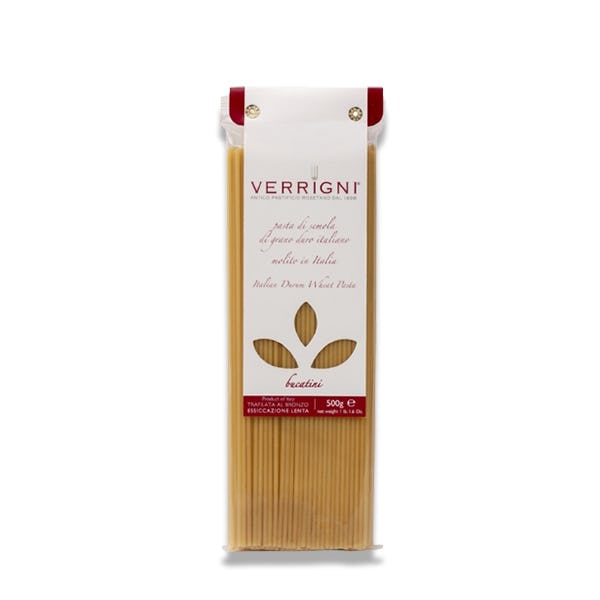
TASTING NOTES FROM THE CURATOR
Bucatini is also called “perciatelli,” and gets its name from the Italian words, “buco,” which means hole, and “bucato,” which means pierced. This pasta looks similar to spaghetti—long strings of pasta, except this one has a hole in the middle, like a tiny tunnel. This shape allows the pasta to get fully coated and filled with sauce.
PREPARATION AND PAIRINGS
Verrigni Bucatini is great with rich, meaty sauces, as those cling wonderfully into the holes. You can easily substitute bucatini with your spaghetti, and use it in whatever spaghetti dish you make. A classic way to enjoy it is bucatini all’ amatriciana, which is a delicious and spicy tomato-based pasta dish.
FROM ROSBURGO TO THE WORLD
Luigi Verrigni founded Antico Pastificio Rosetano in 1898. He supplied fine artisan pasta to noble families in Rosburgo, and thus, the quality of his pastas was already known. His pastas were made with grains ground with stone millstones, then mixed with Gran Sasso water, and dried on bamboo canes. The demand for Verrigni pastas got so big that Luigi’s son, Gaetano, experimented with “dressing rooms,” where he put current fans and other heat sources to create a steady temperature for the pasts drying.
Through the years, Verrigni Pasta has expanded its distribution, introduced the innovative gold die, and in the 1980s, was one of the few pasta factories to sell organic pasta. This made them even more popular. They continue with the innovation, and pushing the boundaries, and trying new things. Verrigni continues to make superior quality pasta, with all the craftsmanship of tradition, and the beauty of technology.
Storage Instructions
Store dry, uncooked pasta in a cool, dry pantry for up to one year. Preserve freshness by storing dry pasta in an air-tight box or container. Store plain (no sauce or other ingredients) cooked pasta in a container or plastic sealable bag in the refrigerator for up to five days and up to three months in the freezer.







